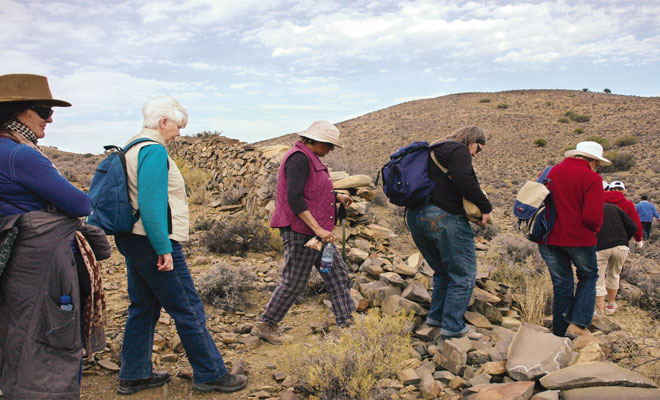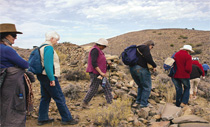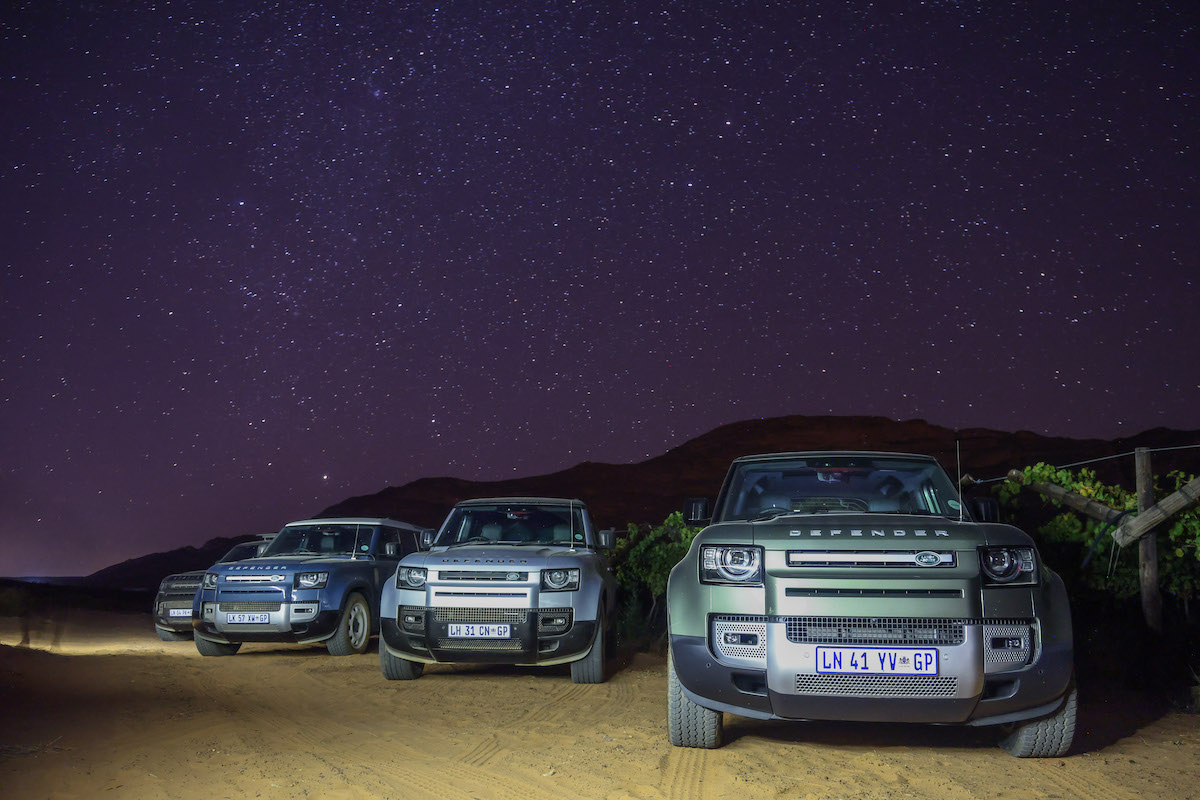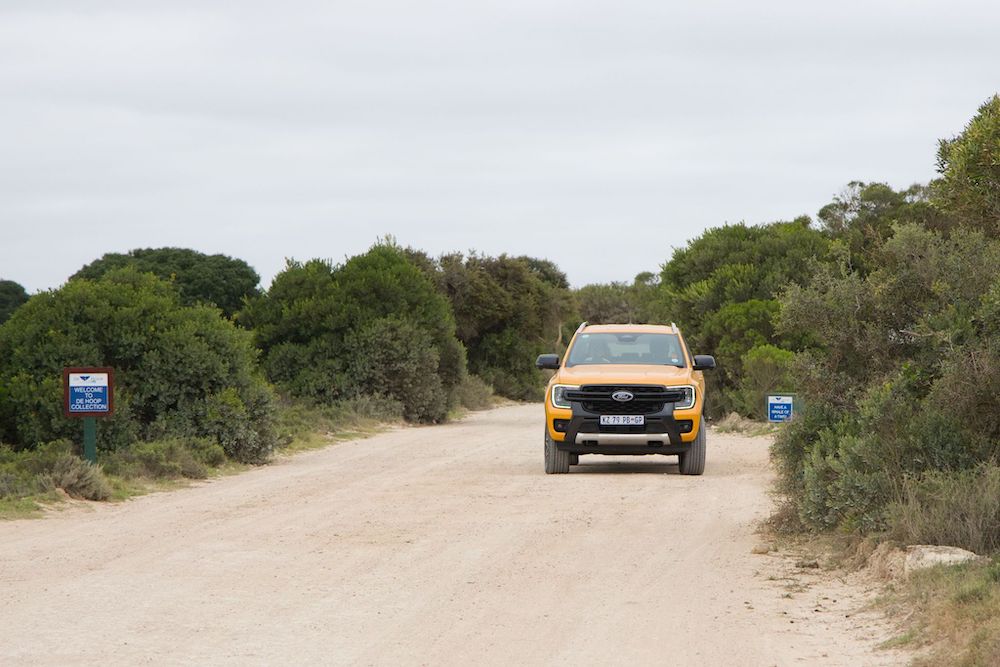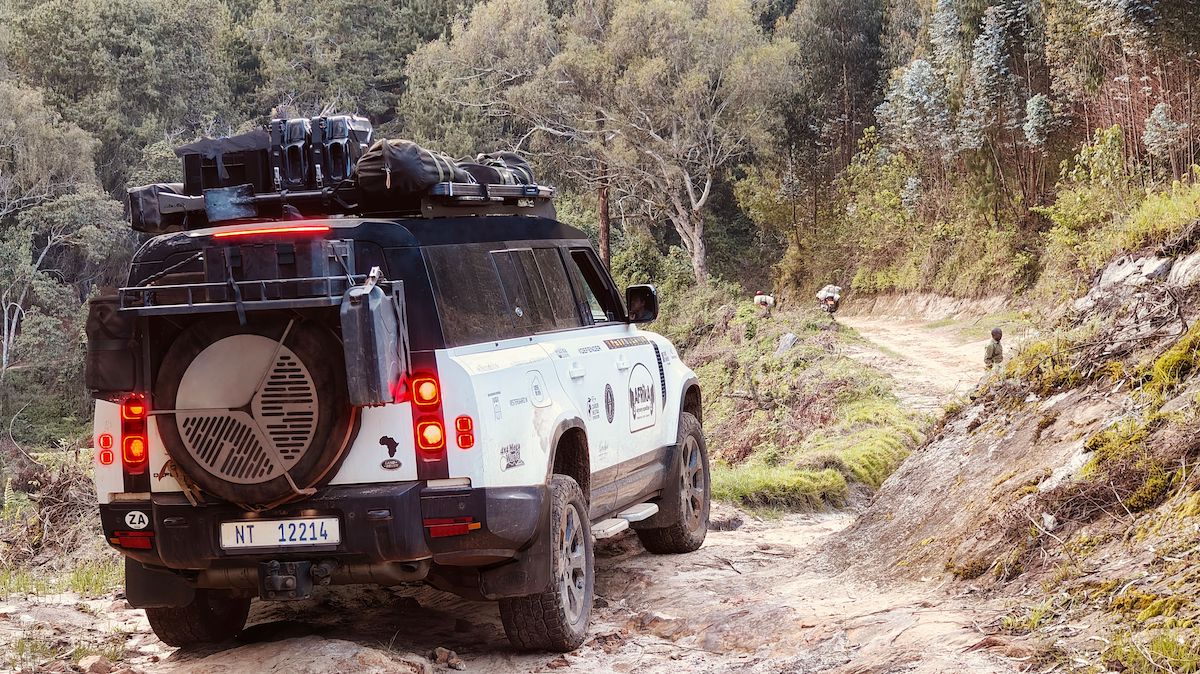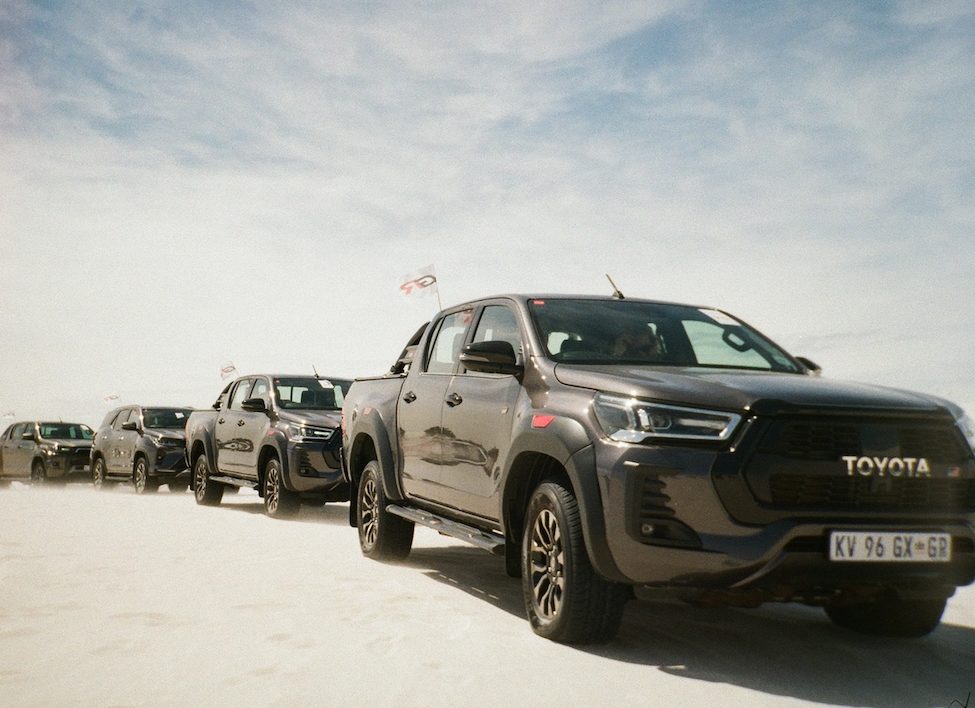If an adventure containing a sturdy dose of history, anthropology, astronomy and archaeology, mixed with some serious 4×4’ing, interesting people, the best Karoo lamb chops ever and a tour leader who speaks eight languages sounds intriguing, Geelbek Farm is your next port of call. Leilani Basson experienced all these things (camera in hand) on a recent quest to fi nd the Indian-inspired temples in the Moordenaars Karoo, 300km from Cape Town.
I was standing in the Kaffersleegte*, a dry riverbed somewhere on an immense farm in the Moordenaars Karoo. The farm is named Geelbek from the Geelbek River that runs through it. The seriously weathered kareeboom in front of me is where the Hottentot people who lived here are said to have been cremated. Their ashes were strewn over the ebbing water to fl ow downstream – back south towards the cave where we started this symbolic journey of birth, life and death about 24 hours ago. The gnarled kareeboom on this sacred site is said to embody the Hott entot god who guarded the borderline between life and death. His name was Kari and his weapon a trident – represented by the trident leaves of this sancti fi ed tree (Rhus lancea). Kari/Karee. Is it a coincidence that these two names sound so similar, depending on how you pronounce them? Ever wondered why it was named a Karee-boom? What is a Karee? Is it Afrikaans or English or some nati ve tongue? One theory is that it is an ancient Indian name of the Dravida (Indian) people’s god. The Dravida is said to be the oldest known civilisation in India, whose men were skilled maritime navigators. They sailed to Africa in search of gold and mixed with the indigenous Bushmen women, leading to the birth of a new progeny: the Hott entot (properly pronounced Otentottu, which describes them as “mixed”) or Quena (pronounced Kena and meaning Red, aft er their Red God). Or so the story goes. Around me there was more evidence of this apparently Indian influence in the names of rivers, koppies and places – which is hard to dispute. According to research, the most common word for river in Quena languages takes three forms: -ka, -kam and -kama. All three of them could be derived from the Dravida word “kam”, for water. Examples of this linguistic influence are the Dwyka, Gamka, Leeugamkarivier, Keiskamma, Tsitsikama, Karikama and Tarakama. Other borrowings from India – names like Ramkop and Kanonfontein (in the Moordenaars Karoo) – are thought to have been phoneti cally adapted by the Dutch. Ram replaced Rama and Kanon replaced the Dravida kanai and Quena //ana. Both these words supposedly had their roots in India.
To confuse things even more, no battle was ever fought anywhere near Kanonkop, which makes the Dutch form of the name even more questionable. Another word in our everyday language that had its roots in India is cash, derived from kash – the earliest man-made gold coins used as currency by the Dravidians. The first ti me I heard the claims of an Indian influence in early South African history and the Hindu-inspired temples in the Moordenaars Karoo was almost a year ago. It was said these “temples” had been mistaken for dilapidated former Bantu cattle kraals, though Bantu people never lived in the region. My curiosity was pricked. I the Jewish, Indian, Egyptian, Mesopotamian and even Christi an calendars (and religion), you should not miss this opportunity. I flew to Cape Town on Friday 24 September (two days aft er the actual spring equinox), and embarked on a 300km solo mission in the comfort of a Nissan Pathfinder. My destination was Geelbek Farm (or Faber’s Kraal as it was called by the Dutch burgers). This is a vast stretch of unspoiled Karoo plains and mountains encompassing some 6000ha. Its name was already shrouded in historical prejudice. Geelbek (yellow mouth) is said to have been the name the Dutch gave the Quena due to their yellowish brown skin tone. The farm’s topography fluctuates substantially. It is a 4×4 enthusiast’s dream of stony outcrops, koppies, a canyon, dry riverbeds that vary from thick, soft sand to rocky, rough terrain demanding 4-low most of the ti me – especially if you want to reach the temples on sun-clocked ti me! A group of people were already congregating at the farmhouse when the Pathfinder came to a dusty halt. Some guests were booked into the farmhouse for the weekend and others into nearby cottages.
just had to go there and get the story myself. I consequently wormed my way onto a guest list to join Dr Cyril Hromník – the controversial researcher making these claims – on a fi eld trip he undertakes four ti mes a year, ti med to coincide with the seasonal equinoxes and solsti ces. This helps observers to understand the mathemati cal and astronomical precision of the advanced people who built these temples. One more thing that had me dead set on going was the “Major Moon Standsti ll” – an astronomic phenomenon that occurs every 18.6 years. It last took place on one of the said weekends in 2006, when the “shift ” in the moon’s rising and setti ng could be observed. The offi cial invitati on I received from Dr Hromník by e-mail read: “You are misled if you accept the archaeological scenario which postulates only some kind of Bantu Iron Age and Bushman Stone Age before the arrival of the Portuguese and the Dutch in South Africa. The real history began 1200 years before the arrival of the Bantuspeakers (Sotho, Tswana, Xhosa, Zulu, etc.); and it wasn’t a primiti ve history either. Gold of Africa att racted to Africa’s shores Dravidian (Indian) gold-seekers and they mixed with the indigenous Kung (Bushmen), producing the Mixed Otentott u (Hott entots) or Quena, whose Coloured descendants form the major part of the Cape Populati on. Later on, the Black Bantu-speakers were brought into the system.
With the Indian gold-seekers came the sophisti cated cosmologically based religion, which called for advanced astronomy and this is refl ected in the thousands of stone temples they built. Surprise, surprise, the Rock Art forms an important part of it. The ancient astronomy of these temples is sti ll working. Yes, the Indo-Quena ancestors of the modern Quena engaged in this kind of scienti fi c pasti me. If you want to understand the Jewish, Indian, Egypti an, Mesopotamian and even Christi an calendars (and religion), you should not miss this opportunity. I fl ew to Cape Town on Friday 24 September (two days aft er the actual spring equinox), and embarked on a 300km solo mission in the comfort of a Nissan Pathfi nder. My desti nati on was Geelbek Farm (or Faber’s Kraal as it was called by the Dutch burgers). This is a vast stretch of unspoiled Karoo plains and mountains encompassing some 6000ha. Its name was already shrouded in historical prejudice. Geelbek (yellow mouth) is said to have been the name the Dutch gave the Quena due to their yellowish brown skin tone.
The farm’s topography fluctuates substanti ally. It is a 4×4 enthusiast’s dream of stony outcrops, koppies, a canyon, dry riverbeds that vary from thick, soft sand to rocky, rough terrain demanding 4-low most of the ti me – especially if you want to reach the temples on sun-clocked ti me! A group of people were already congregati ng at the farmhouse when the Pathfi nder came to a dusty halt. Some guests were booked into the farmhouse for the weekend and others into nearby cott ages. They were an interesti ng bunch, all right. Among them were two Americans, two Poles, two Zimbabweans, a Spanish mother and her son, a Xhosa man, two mining geologists from Gauteng, an Australian student, an arti st from Cape Town, a Quena-related trio from Somerset West, a medical doctor and his wife from Betty’s Bay, Dr Hromník’s son, Marius and the owner of the farm, David Luscombe and his adult children Leshane, Mark and Michelle. The majority were politely competing to share a word with the man we all came to meet before embarking on the field trip at midday. Cyril Hromník is a historian and researcher with an MA in African History and Portuguese and a PhD in African, South Asian and Lati n American history. An authority on the origins of the Quena or Hott entot people, he has an archive of published arti cles and a notorious book, Indo-Africa – towards a new understanding of the history of sub-Saharan Africa (a true eye-opening, bewildering read) under his belt. What makes him even more fascinati ng (to me at least), is his linguisti c skills. He speaks eight languages, and maintains that this helps him identi fy the origins of words and geographical names. This in turn gives insight into the foreign infl uences – and the unrecorded history – that played a role in shaping various civilisati ons, including the Quena. In short, a country’s unwritt en history can be traced by the historical names given to its rivers and mountains, in parti cular. “In our case, Hromnik pointed to the presence of ancient Indian words in indigenous languages and geographical names – words that found their way into the local vocabularly over the years.” Bursti ng with excitement and a desire to rediscover (and hopefully rewrite) history, we braced the wind and followed our “guide” up a rocky slope to our fi rst desti nati on – a shrine close to the Luscombe’s farmhouse. At fi rst glance it seemed insignifi cant, unti l Hromník drew att enti on to the shape of the heap of stones. He said it depicted an arrowhead, pointi ng 28.5 degrees south-west, to a V-shape gap in the Witt eberge, where the sun sets at the summer solsti ce. At the winter solsti ce, the sun rises in a similar V-shape gap at the opposite end of a 51km-long line. Cosmologically connected with the arrowhead, on a faraway hill, was a lone tree*. Getti ng there called for some serious 4×4’ing, and two elderly Polish and two South African ladies teamed up with me (and the Pathfi nder) to tackle the trip in style. As Hromník predicted, a shrine was found under the tree, which beckoned us towards a cave adjacent to the dry Geelbek River bed. The cave and overhangs were covered with red dots and a few rock painti ngs. According to Hromník, these were not Bushmen painti ngs, since there was no historic proof that Bushmen lived in the Karoo in the period when rock art was painted. In fact, he said his studies showed that Bushmen never painted, and none of them ever claimed that their ancestors did so. “They were nature people who lived from the earth and never left behind any evidence of stone structures or other transformati ons when they moved on in search of food and water,” said Hromník in his charming, Slovak accent. “These painti ngs were made by the Quena or Hott entots, the owners of this land when the Portuguese and the Dutch arrived. The original Quena form of the name, Hott entot, was Otentott u, fi rst recorded by the French in 1620 and corrupted by the Dutch into the well-known and oft en abused name, ability to create new life. Hromník believes that Quena women adopted this tradition from their Indian ancestors and came to this cave to pray for children and a fruitful married life. The dots were made by dipping a finger in the pigment called kavi (which is a Dravida Indian word for red ochre), and applied to their forehead and the rock to show their readiness to be mothers.
While inspecting this phenomenon, one of the group picked up a potsherd. After examining it, Hromník identified it as the remnant of a typical thin-walled clay pot – an item synonymous with Quena culture. “Bushmen never made or used clay pots, except when in the employ of the Quena.” From the cave, we followed a labyrinth of what Hromnik said were cosmologically placed stone temples and shrines over many kilometres – all interconnected with precisely measured lines.
After crossing the confluence of the Geelbek and Kaffersleegte rivers, we hiked to two man-made walls that run parallel to each other. This proved to be another hugely intriguing astronomically aligned structure that demonstrated the genius of these early astronomers. “These structures are the longest parallel walls anywhere in Africa south of the equator,” said Hromník. Built in the shape of a funnel on parallel ridges running east to west, these walls represented the spatial corridor through which the sun and all the planets moved in their annual and other cycles. Hence they were used by the ancient Dravida and Quena learned men, called suris, as an observatory where young boys – future suris – could be taught astronomy. This study would prepare the young suris for their religious function in Quena villages.
One of the many functions of these walls was to help in the observation of the rare phenomenon known as the Major Moon Standstill. Where the walls came to a sloped end, Hromník pointed to a heap of small stones which, he said, functioned as a registry of the witnesses of the event. After a long and quite wild ride in the rough river bed following the course southwest, north-east, the Kaffersleegte turned northward and brought us to a temple which Hromník calls Abbu Lingam – the Self-Washed Lingam*. We reached it 20 minutes before sunset, which allowed us a welcome rest, with a sundowner. From here we witnessed the phenomenal accuracy with which the Quena marked the exact position of the setting sun at the spring equinox. The sun set true west from the temple in a cleavage formed by two breast-like hills called Parambu by the Dravida gold seekers and their Quena progeny. “These same koppies were called Pramkoppies by the early Dutch – an archaic word for women’s breats,” explained Hromnik in his humorous, chatty way, ending most of his sentences with an almost Afrikaans-sounding “ja”.He said the sun sets in the cleavage of the Pramkoppies every spring equinox (September 21, 22 or 23) and every autumn equinox (March 21 or 22). Since it was only two days after the equinox that fell on 22 September this year, it was still pretty much in place, less than one sun disk’s width to the left, bearing in mind that the sun was moving from the northern to the southern hemisphere.
The following morning we were up long before dawn. We embarked on a long drive along what used to be the old Quena “ox road” and the later road to Kimberley’s diamond fields, to the Springbokvlakte, where we found several stone shrines. The first one focused on a tall monolith set up in the south against a cleavage in the hills, where we watched the circular motion of the Southern Cross.
“The same tall monolith, in combination with another monolith planted eastwards, was used by the Quena astronomers to measure the position of the rising sun on spring and autumn equinoxes,” said Hromnik. As we huddled together like sheep in an attempt to stay warm, the sun appeared right on the line of these two stones, which ran 1.5 degrees north of true east. The deviation from true east, Hromník explained, was due to the rising terrain. It was mind boggling to think that the sunsets in the Pramkoppies and the sunrise over the two monoliths had been occurring for 1700 to 2000 years, if the theories were correct. “The method used, as well as the fashion in which the temples and shrines were built, is true to the Dravida Indian cosmology and the spatial commands of their religion. Temples like these are abundant in India.”
Amazed by the mathemati cal and geometrical accuracy of what we had just witnessed, we made our way through slippery sands and mud to the Kaff ersleegte riverbed for breakfast around a camp fi re, where David kept the teapot boiling. Thanks to the Pathfi nder’s nift y tracti on control, the ladies believed me to be one heck of a driver. Hromník, in the farm´s narrow-wheeled Tata 4×4, had to work on it! Our guide was peppered with questi ons from inquisiti ve minds, scepti cal thinkers and true believers. The rest enjoyed coff ee on the banks of the river, discussing the intriguing experience.
Our next quest in this life to death journey of the Quena was up a steep, rocky hill and over a dangerous ledge, which made for some comical moments as we crawled along on all fours. We came to another cave. This ti me the entrance was covered with imprints of small hands in a similar red pigment to that in the first cave. It was only when Hromník pointed it out that we realised every hand print was missing a pinky fi nger. “In ancient Indian culture, marriages were mostly arranged with fi nancial or business interests in mind. This led to many girlchildren being promised to a future husband long before they were at a marriageable age.
To make sure the parents honoured this promise, the girl’s pinky fi nger was cut off .” He explained that in Indian tradition, the wives of deceased husbands came here to bid them farewell before their own immolati on. “Indians, as well as their Quena progeny, were not buried but cremated, which explains the absence of graves in this area. Widows were cremated with their husbands.” There was sti ll one last temple to visit before we reached the sacred grounds where the cremati on took place. We followed a path marked by wayside shrines that brought us to this temple.
Here the soul could either depart through the north-facing exit (that represented the direction to heaven) or the southern exit to reincarnati on if the deceased failed to pass judgment. This was the judgment hall, where the karma of the deceased was scruti nised. Beyond this temple there were no further shrines or temples. However, next to the western wall of the judgment hall was an extraordinary seat (created by strategically arranged rocks) orientated perfectly towards a high mountain in the north. It could accommodate one person alone. “Here, the living Quena contemplated their own future journey of life, from the birth in the south-west to the salvation in the north.
This was reachable only by the Moon Way via the north-east, since they believed one could never face God directly. “The shrine contained the fi xed altar and a lingam indicati ng the directi on of the desired post-judgment travel. A male-kal or redemption stone planted next to the lingam indicated that at least one of the deceased Quena was believed to have reached his desti nati on in the north. It was hard to dispute this Indian infl uence that correlates with everything Hromník has discovered and uncovered during his research in India. This India, that was once a world power and leader of the developing world, and which is now again emerging from Briti sh colonialism and years of turmoil as a great democracy and an economic powerhouse. We sat around the fi re like scavengers that night – devouring Hromník’s every word, together with the succulent Karoo lamb chops, straight from the griddle. I went home hungry, though. Hungry to learn more. Hungry to know more. Hungry to discover my own history.
anthropology, astronomy and archaeology, mixed
with some serious 4×4’ing, interesting people, the
best Karoo lamb chops ever and a tour leader
who speaks eight languages sounds intriguing,
Geelbek Farm is your next port of call. Leilani Basson
experienced all these things (camera in hand) on
a recent quest to fi nd the Indian-inspired temples in
the Moordenaars Karoo, 300km from Cape Town
